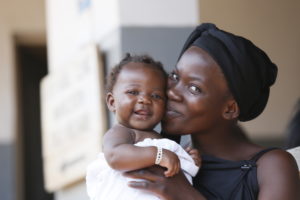
As Shot@Life supporters know, vaccines are one of the most powerful tools in the global fight to improve the health of children and adults around the world. We had the chance to interview Susan Reef about her work on rubella, a mild disease that can have severe implications during pregnancy.
Can you introduce yourself and tell us a little bit about your work with the CDC?
Good afternoon, I am Dr. Susan Reef. I am a medical epidemiologist at the Centers for Disease Control and Prevention (CDC), with 24 years of experience working nationally and internationally on rubella and congenital rubella syndrome (CRS). I am responsible for leading global rubella and CRS epidemiologic, policy and research activities. CDC’s activities include assessing the burden of CRS, documenting the burden of disease, supporting the introduction of rubella vaccine into a country’s routine immunization program, and documenting the elimination of rubella and CRS worldwide.
Can you give us some background on what rubella is and the progress being made to prevent it?
Rubella is a mild rash illness that spreads from person-to-person by droplets shed from the respiratory secretions of infected individuals. Infection early in a pregnancy can lead to serious, even fatal, health outcomes for the baby. As for the status of rubella. Rubella and CRS are no longer endemic in the Region of the Americas. Even with that exciting news, it is estimated that > 100,000 infants are born with CRS globally each year. As of the end of 2017, there are 161 (out of 194) countries that have introduced rubella vaccine into their routine childhood immunization programs.
Rubella and gender issues go hand in hand, as there is a connection between rubella and birth defects. Can you speak about how this happens, the impact it has, why vaccination is so important?
The goal of any rubella vaccination program is the prevention/elimination of congenital rubella infection including congenital rubella syndrome (CRS). The most serious consequences of rubella virus infection occur when a woman becomes infected during pregnancy, particularly during the first trimester. Complications can include miscarriage, fetal death, or a live birth with a constellation of congenital defects known as CRS. The most common defects of CRS affect the eyes (e.g., cataract(s), pigmentary retinopathy, congenital glaucoma), the ears (e.g., sensorineural hearing impairment), and the heart (e.g., patent ductus arteriosus, pulmonary arterial stenosis). Other clinical manifestations of CRS may include microcephaly, developmental delay, and purpura, including dermal erythropoiesis (blueberry muffin syndrome).
Among pregnant women infected with rubella virus during the first ten weeks of gestation, up to 90% of their live-born infants may have congenital rubella syndrome. Among women infected during the first 20 weeks of pregnancy, the rate of congenital rubella syndrome in live born infants is 20%.
Vaccination is critical, safe and effective in preventing infection and saves lives, and prevents disabilities. The only way to prevent CRS is through vaccination.
Are there any innovations in vaccines, particularly with rubella, that excite you? Anything new on the horizon?
No more needles! Researchers are working on microarray patches for measles and rubella vaccines. The patches look like small round band-aids and can easily be pressed onto the skin with no pain. Tiny microscopic projections on the patch release the vaccine into the skin, and then the patch is removed and thrown away.
How have vaccines and their distribution around the world changed in past years? How do you see them changing?
In 2011, the World Health Organization (WHO) updated guidance on the preferred strategy for the introduction of rubella-containing vaccine (RCV) into national immunization schedules. The strategy recommends an initial vaccination campaign, usually targeting children aged nine months–14 years. Additionally, in 2011, GAVI opened a new funding window for the rubella-containing vaccine (RCV) by pledging over 500 million dollars for the introduction of RCV into GAVI countries. With these changes and support, 27 countries have introduced RCV into their routine immunization programs since 2012.
What excites you the most about the work that you are doing?
The most exciting aspect of my work is being able to make a positive impact in the future of a child and family that ultimately uplifts a community. Knowing that we are helping to prevent a child from being born with CRS is what drives me every day.
